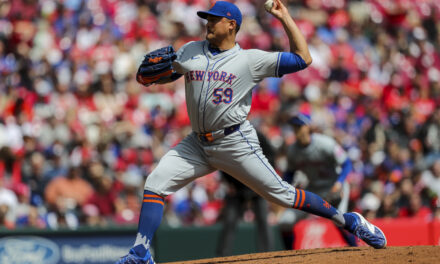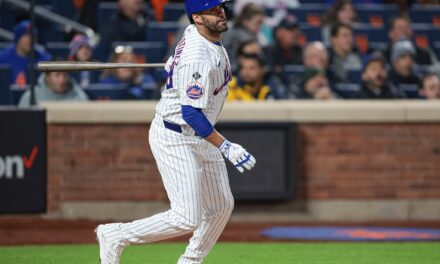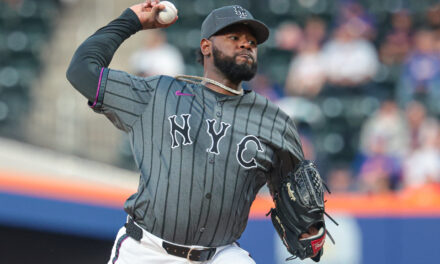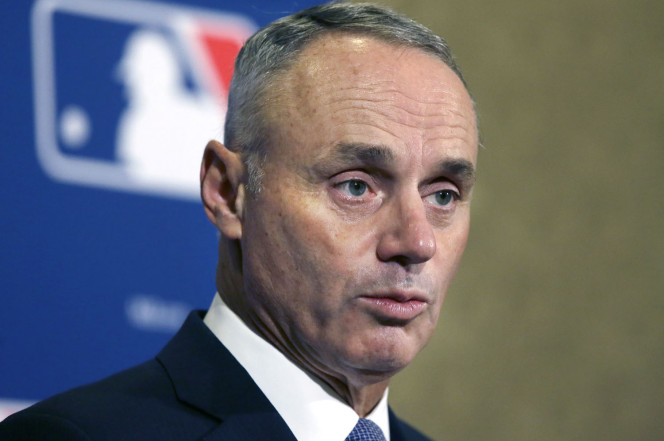
For years now, there has been much discussion as to if we could see the designated hitter in the National League soon.
With talks ramping up lately due to pitchers getting hurt while at bat and a general want for the change, discussion has turned to how soon, not if. But there still seems to be a crowd of fans that believe that the National League should stay away from the DH, keeping their game more pure, and staying with tradition.
The convention and tradition of National League Baseball is what attracts many of their fans to the product, but Marc Carig of The Athletic New York feels that baseball as a whole “is saddled with too many nonsensical realities based solely on the basis of ‘tradition.”
He recollects on how the “DH began as a gimmick to raise offense in a league that lacked stars and firepower.” At the very least, you can make the case that the DH has been a success for the American League since its conception in 1973, and they have no reason to switch back.
But if the DH has worked so well for the American League, why hasn’t the Senior Circuit followed suit?
Tim Kurkjian of ESPN says there has been reluctance from National League owners and executives because “it viewed itself as the superior league, and didn’t need a gimmick such as the DH to make its game better.”
Kurkjian also says that, “The N.L. looked at itself as the more traditional league, the league that was founded first, the league that was going to play by the original rules of the game, including the pitcher batting. The DH was too drastic a change to a game that didn’t need change.”
As to why the N.L. higher-ups haven’t switched today, Jayson Stark of The Athletic told me this.
“The commissioner, Rob Manfred, had a fascinating take on this when he met with the Baseball Writers last week,” Stark said. “If Major League Baseball were to go to a universal DH, that would mean essentially the end of a style of baseball with deep historical and sporting significance – the so-called National League game.
“If the N.L. were to adopt the DH, there would be virtually no major baseball league left on earth in which that style of baseball is played. So it’s a reason to think long and hard about taking this step. ”
Stark reiterated that a prime reason to keep the DH is tradition.
“For a long time, N.L. owners were vociferously opposed to the DH, because of tradition and because of their belief that it’s a more interesting and strategic game. I definitely see that opposition softening, now that the game is evolving away from so many of the strategies and elements of that National League style game.
“Those N.L. owners are also hearing their front offices make those points and reminding them how much more difficult it is for an N.L. team to sign a marquee free agent because the length of deal required is almost a deal-breaker when you don’t have a DH spot for that player as he ages. So I do think the sport is heading in that direction at some point in the next decade and probably sooner. But we’re not there yet. The commissioner said the most likely course right now is the status quo. And I agree with him.”
Stark was asked how, given that starting pitchers don’t pitch as deep into games as they used to, what is the advantage of a DH?
It is really only shown in a few at bats because the National League will pinch hit later in games. So how big of a difference is there between using a DH and pinch hitting?
He responded that pitchers are getting fewer plate appearances than ever anyway. But with teams carrying 13 and sometimes 14 pitchers, benches are short. And it’s a challenge for NL teams to manage the bullpen the way they want to with no DH.
He added that the other difference is that the DH is almost always a higher caliber player than a bench player who would tend to pinch-hit. Stark also pointed out that DH’s had an OPS of .758 entering the All-Star break in 2018. In that same time period, pinch hitters had an OPS of .644, and pitchers carried one of .288. No matter how you cut it, the advantage of having a DH is obvious.
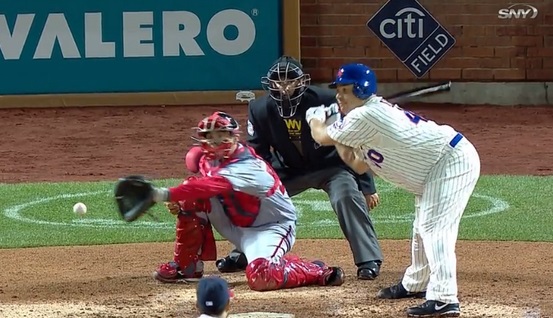
But how many at bats are pitchers really getting per game? Per Elias Sports, pitchers average 1.95 at bats per game. To put that in perspective, in 2008 pitchers averaged 2.15 at bats per game. They had 2.29 per game in 1998, 2.32 in 1988, 2.37 in 1978 and 2.50 in 1968.
So over the last 50 years, pitchers have lost over a half a plate appearance a game. The .20 difference over the last decade is equated to one at bat for every five pitchers. Think of it as “2,2,2,2,2 at bats compared to 2,2,2,2,3 at bats,” Rob Tracy of the Elias Sports Bureau said.
Kurkjian also mentions how the DH effects the business side of the game.
“It is a job, and the Players Association is not in the business of eliminating jobs,” he said. “It also is a high-paying job, and the MLPA really values those. Plus, the DH is being used differently these days. The DH used to be a place for an older player that was incapable of playing in the field. Now the DH is being used more as a place for an everyday player to get a rest from playing the whole game, but he still gets four at-bats.”
When asked about the same idea of a dedicated DH, Carig bluntly said that ” The dedicated DH is basically dead.”
Carig makes the same point as Kurkjian does, and the New York Yankees, the team Carig covers, have used 11 different DH’s in 95 games as of the All-Star Break, hammering home his point: there isn’t just one DH. It is used by multiple players and it will change day to day and game to game.
Even on National League rosters, there are players that profile as DH’s.
These include the Mets’ Wilmer Flores, and the Phillies’ Maikel Franco.
A transition into a roster with a DH should’t be hard for a team, seeing as most players can play DH, and most American League teams shuffle the position around depending on match-ups, player health, and many other factors.
But the point comes back to roster construction, as organizations are built to contend and win a certain brand of baseball. National League rosters are generally built to win with pitching and defense, while American League rosters are heavy on offense. To have to change the blueprint of an entire organization will not be an easy task for any of the 15 National League teams.
A bench in the National League will be more inclined to have players that can succeed off having one at bat a night, and be able to play multiple positions in the case of a double switch.
Opponents of the National League style of baseball speak to how National League managers can have their hand forced by situations and have to adjust their entire game plan on the fly, where American League managers only have to recognize the appropriate time to use a pinch hitter or execute a pitching change.
National League executives are faced with the tough task of constructing a bench that is applicable to that style of play, where an American League bench can generally be a back up catcher and four position players that aren’t good enough to be everyday players.
In the Senior Circuit, you tend to see more pitchers that are capable of hitting, the likes of Madison Bumgarner, Noah Syndergaard, Michael Lorenzen, and Zack Greinke.
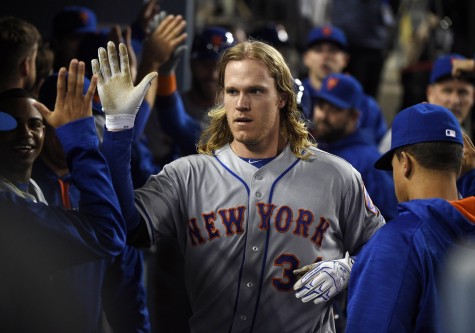
On July 30, 2016, Bruce Bochy of the Giants chose to hit Madison Bumgarner instead of using the DH.
Bochy became the first manager to not use a DH in a game where it was available since 1976, when the White Sox let Ken Brett hit for himself.
Kurkjian said that seeing occurrences like this in a National League with a DH will be “highly unlikely.”
Initially, you might see it with a select handful of guys – a Bumgarner or Michael Lorenzen maybe who can really hit,” Kurkjian said. “But in time, that would totally disappear, because it would mean pitchers never getting to hit anywhere in the world.
“So you’d only see them bat in some sort of emergency. I actually love to watch good-hitting pitchers do their thing. But that’s already a dying art. And it would soon be obsolete as pitchers reached a point where they’d never hit or even practice hitting.”
The National League sees higher average attendance per game, which raised the question: does the National League not having a DH have any effect on these numbers?
Kurkjian says that “He doesn’t elieve the DH has any effect on attendance being higher in the N.L. than the A.L.”
“It has been a strange season, and perhaps not a healthy season,” he said. “In the A.L., three teams, the Red Sox, Yankees and Astros, are on a pace to win over 100 games. And three teams, the Orioles, Royals and White Sox, are on pace to lose over 100 games. It is not good when there’s such a wide gap between the good and bad teams. The AL playoff picture is nearly set, with perhaps only the second Wild Card still in play.
“With so many teams hopelessly out of the playoff race in the A.L., attendance naturally will drop. But in the N.L., nothing is settled. The three division races are up in the air, as are the two Wild Cards. With so many teams having a chance to win, attendance will go up.”
Kurkjian is right. The closest division in the American League is the East, where both teams are on pace to win over 100 games. The second place team in the Central is the Twins, who are six games under .500, and the Astros and Mariners both hold playoff spots out West by at least three games. The only real competition in the A.L. may be between the Mariners and the A’s for the second Wild Card.
In recent years, Rob Manfred has shown how open and in favor of he is of expansion.
The main difference between the American and National League is the DH, so how would adding a DH to the National League effect the prospect of league expansion?
Jayson Stark says it actually might be the other way around.
“Expansion would trigger significant realignment – possibly even the end of the N.L. and A.L. as we’ve known them in favor of more radical geographical realignment,” he said. “And that would mean the end of both ‘interleague play’ as we’ve known it and the old N.L. rules with no DH, because there would be no need to maintain that tradition of separate rules for separate leagues.”
In recent years, we’ve heard rumblings of expansion in Portland and a few other cities, which would cause a realignment of divisions, and the end of the National and American leagues, potentially. With no old school National League ball and no N.L. tradition, there is no reason to keep out the DH.
But will N.L. owners and executives accept the DH and abolish their style of baseball?
Kurkjian recalls a comment from Commissioner Rob Manfred where he, as Kurkjian puts it, “doesn’t think the N.L. was ready to accept the DH because, he said, the N.L. thinks its game is better the way it is, with pitchers hitting, more strategy, double switches, etc.”
Stark feels that “if the N.L. were to adopt the DH, there would be virtually no major baseball league left on earth in which that style of baseball is played. So it’s a reason to think long and hard about taking this step.”
If pitchers hitting is abolished at the major league level, it will likely force a trickle down effect into all MiLB baseball, the college game, and then down to high school, travel leagues, and rec ball; causing an end to all pitchers hitting at any level. The idea of eradicating the pitcher hitting is an idea that goes far beyond just the MLB game.
But the question remains, when will we see the DH in the National League?
Kurkjian says that he doesn’t think Major League Baseball will change to a universal DH in 2019, but maybe it will be ready in three to five years.
Tony Clark, the head of the Players Association, recently said a universal DH was gaining support with the players, but everyone already knew that.
Commissioner Rob Manfred recently said that he didn’t think the NL was ready to accept the DH. Tim puts it at not expecting anything now, but to keep ourselves ready for it.
And as Jayson Stark mentioned, including the DH in both leagues might wait until after we see league expansion and realignment. Said realignment would possibly abolish the National and American Leagues as we know it, and could usher in a new league format like seen in the NBA or NFL.
The National League style of baseball has become a dying art in a league that is trying to catch up with the times.
Soon, the game of baseball you see on the field, with a universal DH, replay, more than thirty teams, will look nothing like the game of old. Since 1973, the American League has seen monumental success with the Designated Hitter, and has ran with the concept of no pitchers hitting.
A universal DH will likely kill inter-league play, trigger league expansion, and dissolve the National and American League format that has been a main stay in baseball for more than 100 years. The debate isn’t just about whether pitchers should hit in the National League or not, it included the massive trickle down effect that holds the fate of baseball in it’s hands.


